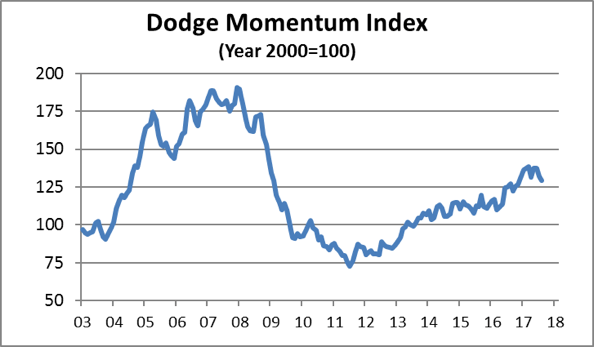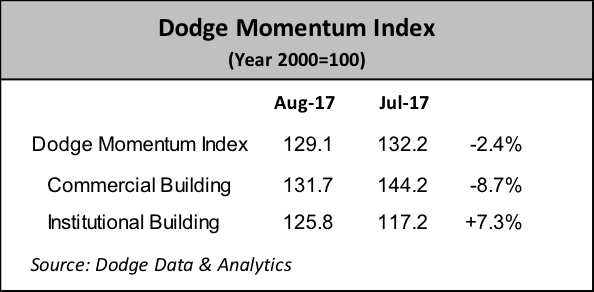NEW YORK – September 8, 2017 – The Dodge Momentum Index moved lower in August, falling 2.4% to 129.1 (2000=100) from its revised July reading of 132.2. The Momentum Index is a monthly measure of the first (or initial) report for nonresidential building projects in planning, which have been shown to lead construction spending for nonresidential buildings by a full year.

Source: Dodge Data & Analytics
The decline in August can be attributed to an 8.7% drop in the commercial component of the Momentum Index, while the institutional component rose 7.3%. The commercial component has seen a steep rise over the past year as large projects – particularly office buildings – entered the planning cycle. The August retreat for the commercial component brings planning activity back to a level more consistent with a sustainable pace of development.
In August, eight projects entered planning each with a value of $100 million or more. For the institutional building sector, the leading projects were the $230 million University of New Mexico hospital replacement project in Albuquerque NM and a $218 million high school in Aledo TX. The leading commercial building projects were the $205 million Niagara Falls Grand Hotel in Niagara Falls NY and a $178 million Amazon fulfillment center in Salem OR.

About Dodge Data & Analytics: Dodge Data & Analytics is North America’s leading provider of analytics and software-based workflow integration solutions for the construction industry. Building product manufacturers, architects, engineers, contractors, and service providers leverage Dodge to identify and pursue unseen growth opportunities and execute on those opportunities for enhanced business performance. Whether it’s on a local, regional or national level, Dodge makes the hidden obvious, empowering its clients to better understand their markets, uncover key relationships, size growth opportunities, and pursue those opportunities with success. The company’s construction project information is the most comprehensive and verified in the industry. Dodge is leveraging its 100-year-old legacy of continuous innovation to help the industry meet the building challenges of the future. To learn more, visit www.construction.com.


